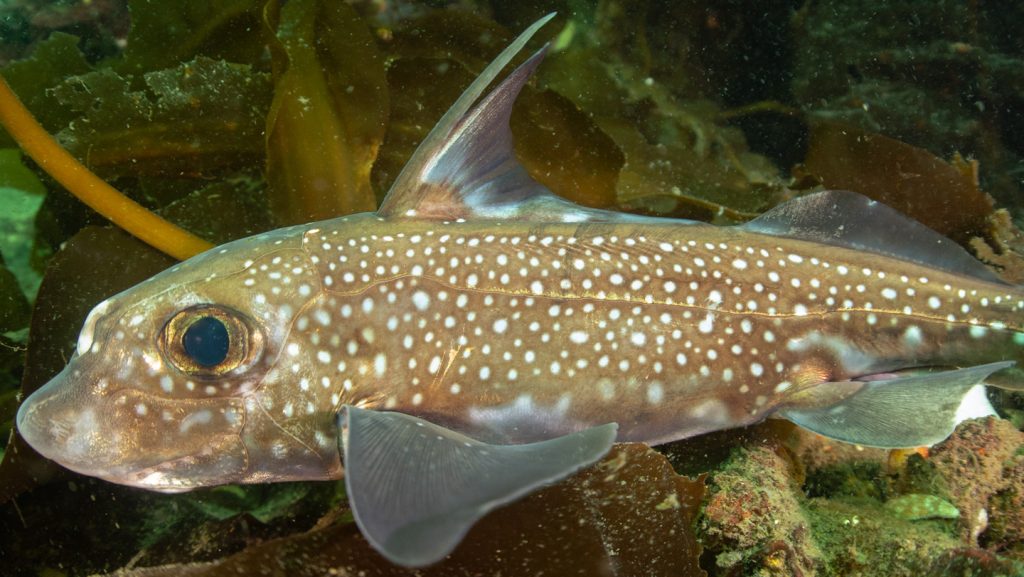The Curious Case of Spotted Ratfish: Ghost Sharks with Forehead Teeth
In the mysterious depths of our oceans, where sunlight barely penetrates and strange creatures roam, scientists have made a remarkable discovery about the spotted ratfish, colloquially known as “ghost sharks.” These enigmatic fish, with their ethereal appearance and haunting presence, have revealed a biological feature previously unknown in the vertebrate world: teeth located on their foreheads. This extraordinary finding represents the first documented case of teeth developing outside of the mouth cavity in any animal, challenging our fundamental understanding of dental evolution and function. The forehead teeth of these deep-sea dwellers aren’t merely anatomical oddities; they serve a critical purpose in the ratfish’s reproductive process, helping males grasp onto females during mating—a fascinating adaptation to the challenges of finding and securing mates in the vast, dark expanse of the ocean depths.
Ghost sharks, despite their spectral nickname, are cartilaginous fish related to sharks and rays, belonging to the ancient class Chondrichthyes that has survived for over 400 million years. Unlike their more famous relatives, ratfish have remained largely mysterious to science, dwelling in depths where human observation is challenging. Their discovery of forehead teeth adds another layer to their already peculiar biology, which includes large, luminescent green eyes that help them navigate the dim ocean depths, and a venomous spine for defense. These creatures, with their rabbit-like faces and tapering bodies, occupy a unique evolutionary branch that diverged from sharks roughly 400 million years ago, making them living fossils that have witnessed the rise and fall of dinosaurs and countless other species throughout Earth’s tumultuous history.
The revelation of teeth outside the mouth challenges long-held biological assumptions and opens new questions about the developmental pathways that govern tooth formation. Traditionally, vertebrate teeth are understood to form exclusively along the jaw margin, within the confines of the oral cavity. The ratfish’s forehead teeth suggest that the genetic instructions for dental development can manifest in unexpected locations, potentially through the redeployment of dental-forming genes outside their typical domains. This discovery invites comparisons to other unusual structures in the animal kingdom, such as the tusks of elephants and narwhals—modified teeth that serve specialized functions beyond feeding. However, the ratfish’s forehead teeth represent something even more remarkable: a completely novel location for dental structures that evolved independently to serve a specific reproductive function.
The reproductive strategy of spotted ratfish illuminates why such an unusual adaptation might have evolved. In the crushing pressures and perpetual darkness of their deep-sea habitat, finding a mate presents formidable challenges. The males’ forehead teeth provide a crucial advantage during mating, allowing them to securely grasp females during copulation—an essential adaptation in an environment where currents are strong and opportunities for reproduction may be fleeting. This innovative solution to the problem of mate retention demonstrates the incredible plasticity of evolution, finding ways to repurpose developmental pathways to create novel structures when survival and reproduction demand it. The discovery also hints at the possibility that other deep-sea creatures might harbor similarly unexpected adaptations, waiting to be discovered in the vastly unexplored oceanic depths that cover most of our planet.
This finding highlights how much remains unknown about ocean life, particularly species inhabiting the deeper, less accessible regions. Despite centuries of scientific inquiry, our understanding of marine biodiversity remains incomplete, with new species and surprising adaptations continuously coming to light. The spotted ratfish, with its forehead teeth, serves as a humbling reminder of nature’s boundless capacity for innovation and the limitations of our current biological knowledge. As technology advances and allows deeper exploration of our oceans, we may discover that what we currently consider biological rules are merely patterns based on our limited observations of life forms accessible to us—predominantly those living on land or in shallow waters. The ghost sharks invite us to reconsider our assumptions and approach the natural world with renewed curiosity and openness to the unexpected.
The story of the spotted ratfish’s unusual dentition also emphasizes the importance of conservation efforts for deep-sea ecosystems, which face increasing threats from deep-sea fishing, mining, and climate change. These ancient creatures have survived multiple mass extinction events over hundreds of millions of years, evolving remarkable adaptations like forehead teeth to thrive in their challenging environment. Yet they may now face unprecedented pressures from human activities that are rapidly altering even the most remote oceanic habitats. By studying and appreciating these extraordinary adaptations, we gain not only scientific knowledge but also compelling reasons to protect the diverse and often bizarre creatures that inhabit our planet’s final frontier—the deep ocean. The ghost sharks, with their unexpected teeth and ethereal presence, remind us that the most astonishing discoveries often come from the places and creatures we understand the least.


